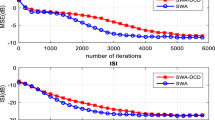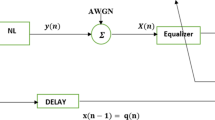Abstract
Improved Square Contour Algorithm (ISCA) is a blind adaptive equalization technique which employs estimated outputs from the decision device along with the dispersion constant in its cost function, thereby, forcing the equalizer outputs to lie on multiple zero error square moduli instead of a single contour in Square Contour Algorithm (SCA). This leads to greater ISI suppression and an improved convergence rate. In this paper, frequency domain implementation of block based ISCA is developed. Simulation results show that the FDISCA exhibits similar performance as time domain ISCA but with a significantly lower computational complexity. However, by employing normalization in the frequency bins, a noteworthy improvement in the convergence rate for FD-ISCA is observed. Complete hardware architecture of FD-ISCA along with its simulation results is also discussed.













Similar content being viewed by others
References
Sklar, B. “Digital communications: fundamentals and applications”.
Godard, D. N. (1980). Self-recovering equalization and carrier tracking in two-dimensional data communication systems”. IEEE Transactions on Communications, COM-24, 656–864.
Yang, J., Werner, J. J., & Dumont, G. A. (2002). The multimodulus blind equalization and its generalized algorithms”. IEEE Journal of Selected Areas Communication, 20(5), 997–1015.
Thaiupathump, T., He, L., & Kassam, S. A. (2006). Square contour algorithm for blind equalization of QAM signals”. Signal Processing, 86(11), 3357–3370.
Sheikh, S. A., & Fan, P. (2008). New blind equalization techniques based on Improved Square Contour Algorithm”. Elsevier Journal on Digital Signal Processing, 18(8), 680–693.
Treichler, J. R., Larimore, M. G., & Harp, J. C. (1998). Practical blind demodulators for High-order QAM signals. Proceedings of the IEEE Special Issue on Blind System Identification and Estimation, 86, 1907–1926.
Gul, M., & Sheikh, S. (2010). Design and implementation of a blind adaptive equalizer using Frequency Domain Square Contour Algorithm. Digital Signal Processing, 20(6), 1697–1710.
Shynk, J. (1989). “Frequency-domain implementations of the constant modulus algorithm”, in: 23rd Asilomer Conference on Signals, Systems and Computers.
Dam, H.H. et al.(2003). “Frequency domain constant modulus algorithm for broadband wireless systems”, in: IEE GLOBECOM.
Banovi ‘ c, K., Khalid, M. A. S., & Abdel-Raheem, E. (2007). A configurable fractionally-spaced blind adaptive equalizer for QAM demodulators”. Digital Signal Processing, 17(6), 1071–1088.
Thaiupatump, T., Kassam, S.A. (2003). Square contour algorithm: “a new algorithm for blind equalization and carrier phase recovery”, in: Proc. 37th Asilomar Conference on Signals, Systems and Computers 647–651.
Author information
Authors and Affiliations
Corresponding author
Appendix A
Appendix A
As mentioned before, for blind equalizer adjustment, a scheme to minimize a special type of non-MSE cost function involving the statistical characteristics of the transmitted data and the output of the equalizer needs to be employed. The generalized expression for the cost function for ISCA is given by [5]:
where p is an integer and its value depending on performance and complexity of implementation is usually set as p = 2 [11]. The error signal is found using the Stochastic Gradient Decent (SGD) Algorithm as:
Substituting p = 2 in (1) and computing its gradient:
Since the value of Λ n (2R ISCA )2 does not depend on the tap weights wn,\( \raisebox{1ex}{$\partial $}\!\left/ \!\raisebox{-1ex}{$\partial {w}_n$}\right.\left[{\varLambda}_n{\left(2{R}_{ISCA}\right)}^2\right]=0 \). So,
We know from the properties of signum function that \( \frac{d}{dx}\left|{x}_r+{x}_i\right|=c\operatorname{sgn}\left({x}_r+{x}_i\right)=\operatorname{sgn}\left({x}_r\right)+j*\operatorname{sgn}\left({x}_i\right) \). Thus,
is the error function used to compute the tap weight vectors.
Rights and permissions
About this article
Cite this article
Khan, S.A., Sheikh, S.A. Design and Implementation of a Blind Adaptive Equalizer Using Frequency Domain Improved Square Contour Algorithm. J Sign Process Syst 85, 235–247 (2016). https://doi.org/10.1007/s11265-015-1072-7
Received:
Revised:
Accepted:
Published:
Issue Date:
DOI: https://doi.org/10.1007/s11265-015-1072-7




